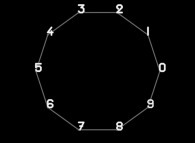
The 1.000 first digits -base 10- of 'pi' displayed on a circle -very bad point of view- [Les 1.000 premières décimales -base 10- de 'pi' visualisées sur un cercle -très mauvais point de vue-].

The 1.000 first digits -base 10- of 'pi' displayed on a circle -very bad point of view- [Les 1.000 premières décimales -base 10- de 'pi' visualisées sur un cercle -très mauvais point de vue-].
 To each digit D inside [0,9] is associated an angle A(D) with the following rule:
To each digit D inside [0,9] is associated an angle A(D) with the following rule:
A(D) = D.(2.pi/10)Then each digit D(n) (n ∈ [1,...]) is displayed as a point (belonging to an helix) with the following tridimensional coordinates:
X = cos(A(D(n)))
Y = sin(A(D(n)))
Z = f(n)
'f' denoting an "arbitrary" function.
 At last, the current picture displays all the segments {D(n),D(n+1)} (for n=1 to 999).
At last, the current picture displays all the segments {D(n),D(n+1)} (for n=1 to 999).






 pi. |
 e. |
 The Golden Ratio. |
 The square root of 2. |
 Champernowne number. |